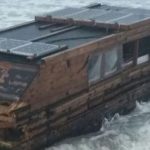April 1989
In April 1989, a state-of-the-art Soviet nuclear submarine called Komsomolets had been carrying out duties underwater for a month. The sub was cruising in the Barents Sea, about 200-miles north of Norway. It was 1,250-feet under the water. Unfortunately, something would happen on this spring day that would result in tragedy. It would also leave behind a legacy of highly toxic radioactive material in the water.
The Cold War
The Komsomolets, the Soviet Submarine first launch occurred during the Cold War. There was a bitter rivalry going on between the Soviet Union and Western powers, including the United States. The Soviets considered the Komsomolets to be a key part of the arms race. It was the only one of its kind ever built. It was designed to be a prototype vessel for the newest generation of Soviet nuclear subs.
The Sinking
On April 7, 1989, the Komsomolets, the Soviet Submarine sank to the bottom of the Barents Sea. Onboard were two nuclear weapons that contained deadly plutonium. It also had a nuclear reactor that powered the vessel. After the ship sank, experts were worried about potential leaks of the deadly cargo. This has been a very serious concern ever since it sank.
The Original Concept
Although the Komsomolets was sailed in the 80s, the concept of the vessel was not new. In 1939, a researcher named Ross Gunn from the U.S. Naval Research Laboratory came up with the idea. The idea may have been developed in the late 30s, but it wasn’t until January 1955 that the first nuclear-powered sub would make it to the open ocean. The vessel was dubbed the USS Nautilus. The advantage of a nuclear-powered sub was that it could remain beneath the waves for more extended periods than if it were on a conventional vessel.
K-19
The Komsomolets wasn’t the Soviet’s first nuclear-powered ship to come to a tragic end. The K-19 met a catastrophic end, and people died. In fact, 11 people were killed after being exposed to high levels of radiation when the reactor system failed. Over the next two years, 17 crew members lost their lives due to radiation poisoning. In 1972, a fire on board killed 30 more people. All of these disasters made people superstitious. Based on all the accidents, sailors nicknamed the K-19, Hiroshima. People believe that the ship was doomed from the beginning.
For good luck, it is customary for a woman to break a bottle of champagne on the boat before its maiden voyage. Before the K-19s maiden journey, a man broke the bottle instead of a woman. Things got worse when the bottle rebounded off the hull’s rubber coating. These two things combined were considered bad omens, which people believe is why so many people died aboard the ship. All of the tragedy and death didn’t stop the Soviets from building another nuclear sub.
Komsomolets
When the sub was built, it was known as the K-278. It was built in the biggest shipyard in the world, and it contained a double hull made out of titanium. The ship was 400-feet long, 27-feet across, and 37-feet tall. Because the hull was made from titanium, the Soviets believed it would help it dive down to depths much deeper than other subs at the time. The deepest the vessel ever went was 3,350-feet. It was designed to operate at 3,-000 feet. At first, it was a test model. The Soviets did use the ship occasionally for patrols.
Emergency Plan
The vessel was divided into seven sections. Compartments two and three were used as safety areas. The bulkheads were strengthened so that they could be a place for the crew to go in case of an emergency. Unfortunately, they needed to use these sections of the vessel. The number of crew members was less than other vessels. The standard crew roster consisted of 12 petty officers and ordinary sailors. There were 30 officers and 22 warrant officers, for a total of 64 men.
The Incident
The incident occurred on April 7, 1989, shortly after 11 am. On that day, the vessel was cruising at a depth of 1,250-feet below the Norwegian Sea. On this day, the sub’s stern was cracked. Suddenly, nothing was working. A shower of hot oil caught on fire, and it was fueled by the oxygen from a broken pipe. When the instruments showed a considerable increase in the temperature in compartment seven, the crew tried to get it under control.
A Death
While trying to put the blaze out, Seaman Bukhnikashvii died. He was suffocated and killed by the intense flames. The crew realized that it would be impossible to stop the fire. With the safety mechanics shutting down, the crew was worried about a meltdown. The officer in charge decided to cut the power altogether. At 11:13a, the vessel was stuck at 500-feet with no driving force or controls. Finally, the crew was ordered off-board. A few hours later, with the crew on life rafts, the vessel sank. There were still six crew members on board, and only one survived.
Lethal Pollution
The two nuclear warheads onboard and the nuclear reactor put the vessel at significant risk of leaking harmful pollution in the ocean. Since the Russians assumed that the ship was safe, they left it in the water. In 1994, it was determined that the plutonium from the warheads had leaked. Cracks caused dangerous, toxic materials to leak into the ocean. The sunken Soviet submarine that’s leaking vast amounts of deadly waste still remains in the water today. This is causing a huge risk for everyone.


